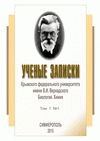Aluminum is widespread in the earth’s crust and is widely used in human economic activity, but its physiological functions in plants have not been fully clarified. The direction of the influence of various concentrations of aluminum nanoparticles on the growth and development of plants, as well as the features of physiological and biochemical processes in them, remain insufficiently studied. The reaction of common oat (Avena sativa L.) to the presence of aluminum nanoparticles in the plant growing substrate was studied under the conditions of a pot experiment. The introduction of aluminum nanoparticles into the substrate at concentrations of 100 and 1000 mg/kg reduces the content of chlorophylls a and b in the leaves at the early stages of plant development. At the same time, at the heading and milky ripeness stages, the amount of chlorophylls and carotenoids increases in the variants using nanoparticles. Changes in the content of photosynthetic pigments indicate a restructuring of the adaptive mechanisms of plants in the presence of aluminum nanoparticles. In the main stages of oat development (tillering, heading, milky ripeness), the chlorophyll ratio (a/b) was within 2.1–3.2, which indicates compensated work of the pigment complex in the presence of nanoparticles in the substrate. During the main development phases, oats grown in the presence of increasing doses of aluminum nanoparticles (10, 100 and 1000 mg/kg) showed a reliable decrease in catalase activity and an increase in peroxidase activity in the leaves and roots of plants. The identified trends in the change in the activity of antioxidant enzymes indicate the reaction of the plant organism to unfavorable environmental factors. The content of aluminum nanoparticles in the oat growing substrate at a concentration of 1000 mg/kg leads to a decrease in the root mass in the tillering phase, as well as the aboveground mass of plants in the tillering, heading and milk ripeness phases. The height of plants, the length of inflorescences, the number and weight of grains also decrease, which indicates a negative impact of high concentrations of aluminum nanoparticles on the production process.
Avena sativa L., aluminum nanoparticles, photosynthetic pigments, antioxidant enzymes, crop structure, productivity.
1. Colman B. P. Low concentrations of silver nanoparticles in biosolids cause adverse ecosystem responses under realistic field scenario / B. P. Colman, C. L. Arnaout, S. Anciaux [et al.] // PLoS ONE. – 2013. – Vol. 8
2. Dykman L. A. Vzaimodeystvie rasteniy s nanochasticami blagorodnyh metallov (obzor) / L. A. Dykman, S. Yu. Schegolev // Sel'skohozyaystvennaya biologiya. – 2017. – № 1. – S. 13–24.
3. Schwab F. Barriers, pathways and processes for uptake, translocation and accumulation of nanomaterials in plants – Critical review / F. Schwab, G. Zhai, M. Kern [et al.] // Nanotoxicology. – 2016 – Vol. 10, Iss. 3.
4. Stasova V. V. Fotosinteticheskie pigmenty v list'yah berezy povisloy pri tehnogennom vozdeystvii / V. V. Stasova, L. N. Skripal'schikova, N. V. Astrahanceva, A. P. Barchenkov // Izvestiya vuzov.
5. Khlebtsov N. G. Biodistribution and toxicity of engineered gold nanoparticles: A review of in vitro and in vivo studies / N. G. Khlebtsov, L. A. Dykman // Chem. Soc. Rev. – 2011. – Vol. 40, Iss. 3. – P. 1647–1671.
6. Yanık F. Toxic effects of aluminum oxide (Al2O3) nanoparticles on root growth and development in Triticum aestivum / F. Yanık, F. Vardar // Water, Air, and Soil Pollution. – 2015. – Vol. 226, Iss. 9. – P. 296.
7. Odat N. Genotypic variation in germination and some growth parameters of wheat (Triticum turgidum spp. Durum) in response to the toxic effect of aluminum oxide (Al2O3) nanoparticles / N. Odat
8. Burklew C. E. Effects of aluminum oxide nanoparticles on the growth, development, and microRNA expression of tobacco (Nicotiana tabacum) / C. E. Burklew, J. Ashlock, W. B. Winfrey, B. Zhang // PLoS
9. Metodika vypolneniya izmereniy vshozhesti semyan i dliny korney prorostkov vysshih rasteniy dlya opredeleniya toksichnosti tehnogenno-zagryaznennyh pochv. FR 1.39.2006.02264. – SPb, 2009.
10. Wellburn A. R. The spectral determination of chlorophylls a and b, as well as total carotenoids, using various solvents with spectrophotometers of different resolutions / A. R. Wellburn//J. Plant Physiol.–1994.
11. Voskresenskaya O. L. Bol'shoy praktikum po bioekologii. Ch. 1 : ucheb. posobie / Mar. gos. un-t; O. L. Voskresenskaya, E. A. Alyabysheva, M. G. Polovnikova. – Yoshkar-Ola, 2006. –107 s. – ISBN 5-94808-239-3
12. Dospehov B. A. Metodika polevogo opyta (s osnovami statisticheskoy obrabotki rezul'tatov issledovaniy) : uchebnik [dlya studentov vysshih s.-h. ucheb. zavedeniy po agronom. spec.]
13. Shubina A. G. Sochetannoe vliyanie himicheskih faktorov vneshney sredy na soderzhanie pigmentov v prorostkah goroha posevnogo Pisum sativum / A. G. Shubina, L. V. Rozenblyum, S. E. Sinyutina
14. Dymova O. V. Fotosinteticheskie pigmenty v rasteniyah prirodnoy flory taezhnoy zony evropeyskogo severo-vostoka Rossii / O. V. Dymova, T. K. Golovko // Fiziologiya rasteniy. – 2019.
15. Kavelenova L. M. K metodologii ekofiziologicheskih issledovaniy list'ev drevesnyh rasteniy / L. M. Kavelenova, E. V. Malyhina, S. A. Rozno, Yu. V. Smirnov // Povolzh. ekol. zhurn. – 2008. – № 3.
16. Wen Y. Co-exposure of silver nanoparticles and chiral herbicide imazethapyr to Arabidopsis thaliana: Enantioselective effects/Y. Wen, L. Zhang, Z. Chen [et al.] // Chemosphere. – 2016.–Vol.145 – R. 207





